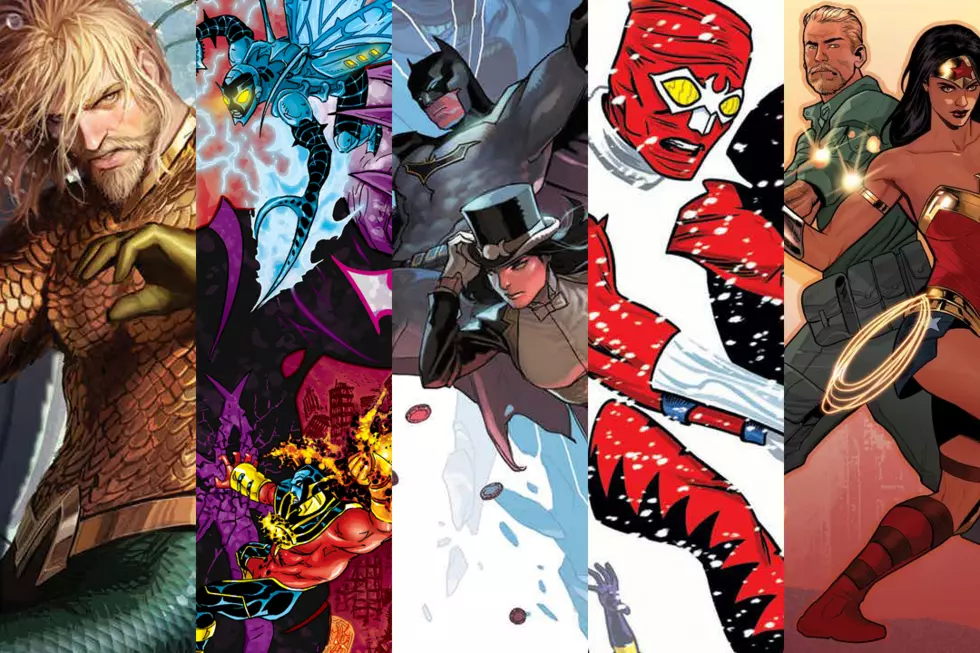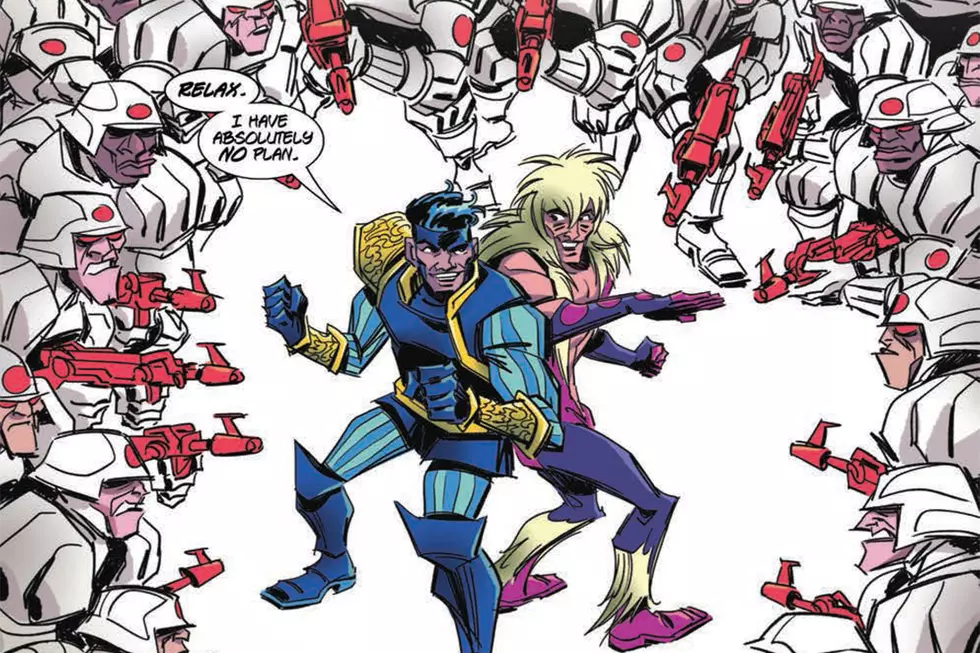
ComicsAlliance’s Best Comics of 2009: #4-2
ComicsAlliance's Best of 2009 list continues!
#4 Scott Pilgrim Vol. 5: Scott Pilgrim Vs. The Universe (Oni Press), Bryan Lee O'Malley

When we last saw our frequently hapless sort-of hero, Scott Pilgrim, he had shockingly started to get it together, just like the title of the last book promised. He got a job, told Ramona he loved her, moved in with her, and generally started to behave more like a grownup than a 23-year-old man-child who avoids responsibility at all costs.
But after four volumes of action-comedy-romance where Scott's most difficult opponent has generally been himself, Vol. 5 changes the game by forcing him to face the most difficult challenge of all: The fact that not everything is about him, even his own book.After all, the series up until this point has literally been the Scott Pilgrim show, and virtually everything, including his relationship with Ramona, has been presented in terms of how it affects Scott and his "precious little life." And now that he's come out (mostly) on top, it would seems like it's time for blue skies and bonus levels. Except that while he was busy fighting evil exes and trying to achieve basic life competence, everyone else was busy living too. And maybe, possibly, the people around him have their own problems to deal with.
Like Ramona, who is suddenly acting very, very weird. The strange, glowing light that suddenly surrounded her head in the first book is back with a vengeance, and while we don't know exactly what it means, it's obviously bad news. (My theory? It's a sign of damage, like when video game characters take a hit and start flashing.)
And while she seems to spend the entire book in a state of low-grade irritation with Scott, he's probably a better boyfriend now than he's ever been before. Again, it's not really about him. Given our brief glimpse into Ramona's dreamscape where we saw her curled up like a dog at the feet of her ex-boyfriend, Gideon, how she's still keeping an unsent letter labeled "GIDEON" in her desk, her complete freakouts every time someone mentions New York, and the fact that she's cheated on pretty much everyone she's ever dated, we can guess that the lady has some issues – probably a lot more serious than Scott's issues, which are mostly that sometimes he sucks.
Now it's her turn to deal with the past, and she does it by looking for reasons to run. Scott, naturally, doesn't realize this until it is possibly too late, because he is busy being self-absorbed and focusing on things like silly battles with robots, because he thinks the narrative of this book is going to be just like all the other books that came before it. That it's all going to be about him. And it's not.

Meanwhile, Ramona, who quit smoking in college, stands on balconies flicking cigarette butts into the dark, stares blankly out windows when Scott talks about how much he cares about her, and cuts off all her hair.
Towards the end of the book, Scott turns to someone and says, "Sorry for everything. Sorry for me." It's an apology he probably owes a lot of people, but the irony is that he isn't even the problem anymore. In the past, his successes have been rewarded (literally) with bonus points and special items and 1ups, and now he gets nothing, because life is not a video game, and leveling up – or growing up – doesn't always end with a victory dance, and that you can't always solve other people's problems through punching. Or solve them at all.
A few pages later, Scott sits in the snow, arms curled around his knees, while the pixelized words CONTINUE? hang beneath him.
And to his credit, he does.
-Laura Hudson
#3 Parker: The Hunter (IDW) Darwyn Cooke

Above is an image from near the beginning of "The Hunter," an establishing shot of an NYC DMV, where the sign for the building is cut off by the edge of the panel frame, so that it simply reads "Dept. of Motor." Whether it was intentional or not, it functions as a label for the whole first section of the book, and for the main character it introduces us to, and for the sweep of his story: forward momentum. Parker, the anti-hero, is a shark. The first 27 pages of the book are relentless motion, stopped only when something literally hits a brick wall.
Adapted by cartoonist Darwyn Cooke from the novel of the same name by Donald Westlake (published under the name Richard Stark, originally) "The Hunter" follows Parker, the quintessential lone wolf badass, on a straightforward revenge gig. The plot isn't complicated, containing just enough twists to be engaging. The characters aren't complex, just embellished enough to carry weight. The strengths of the book are the strengths of the main character: a lean, focused commitment to moving forward and getting the job done.
Parker is not a hero. Double-crossed by a partner who took the money and left Parker for dead, Parker wants only two things now: the double-crosser dead, and the money back. He doesn't care about friends or neighbors; he doesn't care about lives or feelings. At the beginning of the book he walks into New York City, a confident stride moving him through traffic, across city blocks, towards his goal.

Once in the city, he plays it like a big musical instrument, some machine for which he knows all the buttons and levers. He moves from building to building, person to person, and all he cares about any of them is what he can get out of them that he needs. He doesn't win by being righteous, or even really all that clever. He wins by knowing in his heart that everyone else is weaker than him and being mean enough to prove it.
Cooke keeps his art hard and fast, with loose and lean animation-inspired character designs, deep blacks for shading, and a washed-out blue-gray as the single color in his palette, infusing everything with a detached cool. The book's pared-down style pays direct homage to Westlake's prose, and one of the best choices Cooke makes is to periodically stop adapting the story into strict comics, fade into the background, and shift Westlake's prose itself into the spotlight.
The movement back and forth from (for lack of better differentiating terms) pure comics to illustrated prose allows Cooke to create breathing room between his kinetic charges, and also serves to show how malleable the comics form can be in service of even the most direct adventure story. "The Hunter" is the very best in popcorn reads, to be devoured in a single breakneck sitting, to be moved through as Parker moves through the city. The ultimate bastard is triumphant in the ultimate bastard medium.
-Jason Michelitch
#2 Detective Comics (DC Comics) Greg Rucka and J.H. Williams III

It is difficult to consider Batwoman without first considering Batman, since like it or not she is taking his name, and everything that comes with it, as surely as if she had married him. And while everyone certainly expected the 21st century version to leave the Bat-Lipstick back in the Silver Age, it would have been very easy for her to fall into the same trap as so many heroines who add "She-" or "-woman" to the names of established heroes, dress up in swimsuit-shaped costumes with similar color schemes, and generally prance around like secondary characters too unoriginal to have an identity of their own.
But in a matter of months, Greg Rucka and artist J.H. Williams III have made Batwoman – and her alter ego Kate Kane – a force to be reckoned with, a nuanced, dynamic character with an origin story that can rate among the best in the history of superheroes.
Even in the expert hands of Rucka, who has made something of a career out of writing strong women, she has been a surprise, emerging not only three dimensions but in extraordinarily complex ones, with a backstory as compelling as that of Batman himself. And while she shares similarities with Bruce Wayne and his alter ego – a wealthy family, a childhood tragedy, a personal code, and a passion for justice – she is utterly herself.
One notable distinction is that despite their equally traumatic pasts, she seems far more well-adjusted than the Dark Knight. Granted, she's still dressing up like a bat and fighting crime, but where Batman is pathologically obsessive, she seems determined, but fluid; where Batman compartmentalizes his identity to the point of disassociation, she moves easily and organically between the different identities, as though they somehow comprised a whole, rather than dividing her into pieces.
The alter ego in superhero comics typically functions in one of two way: as the real identity of the person who puts on the mask, or as a way of hiding it. For Kate Kane, it is neither; it is one way the light moves through the glass, one way her life turns and reflects through the lens of the moment.
For me, this is the central narrative of Batwoman, and why she has become more interesting to me than even the Dark Knight himself: She has lived through horror and emerged as a hero, not by becoming someone else, but by continually reinterpreting herself, sometimes from moment to moment.

It's a process that plays out very visually, thanks to the consistently stunning work of J.H. Williams III, who brings a distinctly different visual style to each new iteration of Kate Kane. Whenever Batwoman appears, for example, the page seems around her seem to shatter, breaking into a series of clean, angular shards full of precise violence and personal menace.
Much of the art could be called geometric, but it might be more accurate to describe many of layouts as an homage to stained glass windows. Which are, after all, a form of sequential art that dates back to the Middle Ages, when they brought the story of Bible to the illiterate through narrative windows -- panels made of glass. Here, in the cathedral of this comic, Williams borrows from the medieval art to tell a different sort of legend, but the result is no less magnificent.

The first time we see Kate Kane shift is the moment when she transitions from Batwoman to her civilian identity after a night on patrol, where those same fragments, jagged like lightning, suddenly fan out and resolve into loveliness – Kate at home, smiling, framed by dawn in the windows behind her and bathed in pastels. And suddenly the next page is a sea of squares, all 90 degree angles that are equally precise but far more benign, Kate in a world of daylight, glazed with yellow, where everything is bright and common.

Kate has never been just one simple thing, after all; she has never had that luxury, for numerous reasons. And now she has made a profession out of her ability to move in and out of these boxes, eluding categorization the way she has her entire life. It makes just as much sense for her to move between the identities of socialite and crimefighter as it does to move between eyeliner and fashionable tanktops on a date to sweatpants, weightlifting, and military jargon with her father, the colonel to dancing in dashing tuxedo at a high society event.
Or being a West Point cadet, a lesbian, a dropout, a flirt, a lost soul who looked for answers in a bottle, a survivor who saw her mother get shot in head when she was 12 years old, and a warrior capable of exuding all the menace and dread of Batman himself, when she wants to.
She's every one of these things, as much as the others. She's a human being. She's complicated. Aren't we all?
-Laura Hudson
More From ComicsAlliance





![‘Batwoman’ #1 Delivers A Globetrotting Gay Adventure [Review]](http://townsquare.media/site/622/files/2017/03/BW_featured.jpg?w=980&q=75)


![Comics’ Sexiest Female Characters (From A Queer Perspective) [Love & Sex Week]](http://townsquare.media/site/622/files/2017/02/hg_featured.jpg?w=980&q=75)
